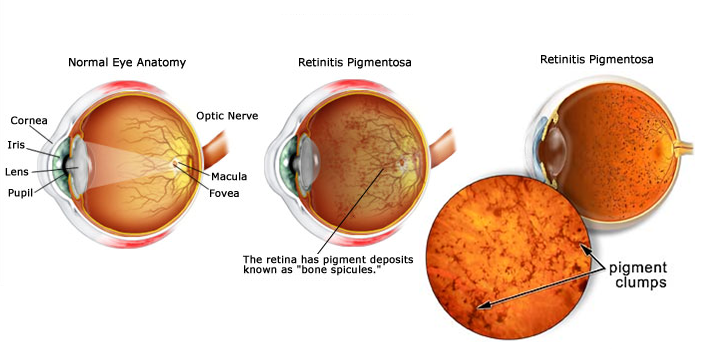Retinitis Pigmentosa (RP) symptoms often appear during childhood or adolescence, a time when occasional clumsy periods aren’t uncommon … In reality, however, an awkward phase may not be the cause of frequent falls or sudden difficulty playing sports. In some cases, the symptoms may be due to decreased side (peripheral) vision or night blindness caused by RP.
What Causes RP?
RP occurs when retinal photoreceptor cells called rods and cones begin to degenerate. The retina lines the back of the eye and converts light rays into electrical impulses that are sent to the brain via the optic nerve. Rods are necessary for good peripheral vision and also make it much easier to see at night and in low light conditions. Cones are responsible for central and color vision and the ability to see images clearly.
Cell degeneration often starts at the margins of the retina where the rods are grouped. Over time, cones also begin to generate too.
What Are the Symptoms of RP?
Loss of peripheral vision, commonly known as tunnel vision, is often one of the first symptoms of RP. A visit to your Kansas City ophthalmologist is a must if you or your children notice a change in peripheral vision. In addition to RP, tunnel vision can also be caused by a concussion, stroke, neurological problems or detached retina. Night blindness often accompanies loss of peripheral vision.
Some people experience decreased central vision as a first symptom or RP instead of peripheral vision loss and may also notice that it’s harder to distinguish colors.
How Does RP Progress?
RP worsens over time, although the exact time frame varies from person to person. Total blindness does occur in some cases, although it’s not unusual to retain a small amount of central vision in the later phases of the disease.
How is RP Inherited?
RP is transmitted through recessive, dominant and X-linked inheritance. In recessive inheritance, neither parent has RP but both pass a faulty gene on to a child. The combination of the two faulty genes cause RP.
Dominant inheritance occurs when a parent who has RP passes the dominant gene on to a child, while X-linked inheritance happens when a mother passes the RP gene on to her son via the X chromosome.
Is There a Cure for RP?
Although there currently isn’t a cure for RP, scientists are conducting multiple research projects to find an effective treatment. The Foundation Fighting Blindness reports that a possible vision-restoring form of gene therapy has been submitted for approval to the U.S. Food and Drug administration. If the treatment is approved, a healthy copy of the RPE65 gene would be placed in the retina to improve vision. Several other gene therapy studies are also underway.
There are no medications used to treat RP, but taking a vitamin every day may just help you preserve your vision. According to research by the National Eye Institute, 15,000 international units of vitamin A palmitate daily may be helpful in slowing RP progression in adults.
Some people who have RP may benefit from the Argus II, a retinal implant that takes over for degenerating photoreceptor cells and may restore a little usable vision in late-stage RP. People who receive implants wear special glasses that sends signals to the brain through a small computer worn on their bodies.
If you have RP, our Kansas City eye doctors can recommend low vision aids that will help you make the most of your remaining vision. Field viewers and expanders, telescopic lenses, computer programs for the visually impaired, magnifiers and yellow or amber eyeglass lenses that reduce glare can be helpful.
Whether you have RP or more common eye problems or eye diseases, regular eye care is the key to protecting your vision. Contact us if you’re worried about an eye problem or would like to schedule a comprehensive vision examination at our Kansas City eye care clinic.
*Image courtesy of Williamson Eye Institute
Posted September 3, 2018 by Silverstein Eye Centers